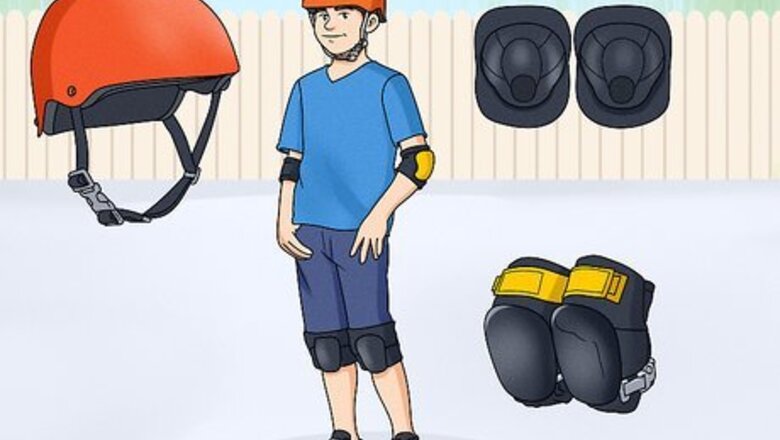
views
Get them the right safety gear.

Grab a helmet, knee pads, and elbow pads, just in case they fall. Your child will feel much safer that way, and you’ll probably have more peace of mind, too! Check your local sporting goods stores for child-sized safety gear, and make sure it all fits them well before their first lesson. The style of skates you choose is important, too. For beginners, you’ll probably want to get them quad roller skates for extra stability. As your child gets older and gains more confidence, they can move up to inline skates.
Be patient, and offer lots of encouragement.
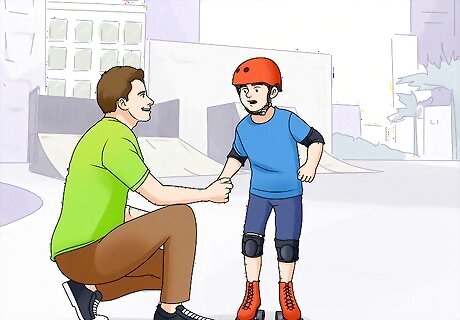
The right attitude can make your child feel safe and secure. If your child is feeling nervous, encourage them by reminding them that everyone starts as a beginner, and they’ll get better over time. If you’re a skater too, it might help if you strap on your skates and head out with your child so they can watch you. Be sure to check in with your child often, and slow down if you need to. If you’re having trouble teaching your child on your own, consider signing them up for classes at your local roller rink.
Skate on a carpet if your child is nervous.
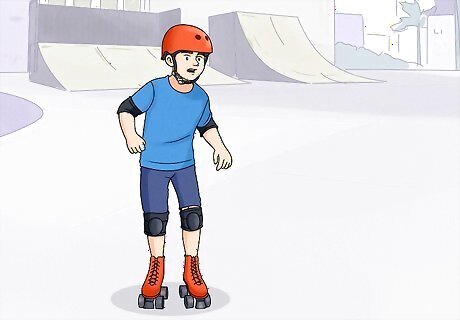
You can’t skate as fast on carpet, which is great for beginners. If your child is nervous about falling over on concrete, stay inside and pick an area that’s carpeted to start out. You can also head to your local gymnastics gym to see if you can use a carpeted room for a little while. It’s tough to go fast or fall over on carpet, so your child can learn the basics without fear of hurting themselves. If you’re going to skate inside your home, make sure you have a pretty large area to work with. Once your child is comfortable with walking and gliding in their skates, you can move on to hardwood or concrete flooring. Either practice outside in a large, flat area, or find a gym or community center with a wooden roller rink you can use.
Start with the right posture.
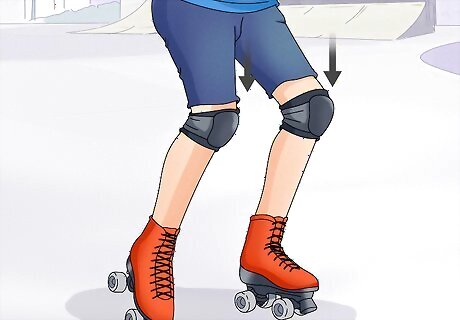
Tell your child to bend their knees and lean forward slightly. If they start to lose their balance, have them put their arms out to the side to steady themselves. Get them to lean slightly forward so they can maintain their balance when they start to glide. The right posture will save your child from injury if they fall over. Spend 5 to 10 minutes working on their posture, and have them go from standing upright to correct skating posture a few times in a row.
Teach your child to walk in their skates.
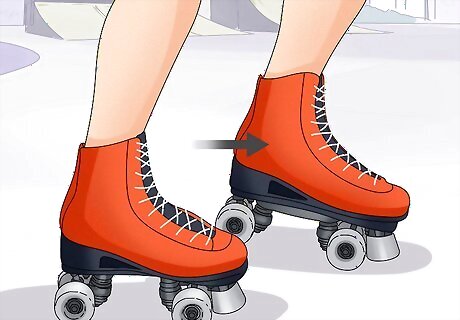
Tell them to pick up each foot one at a time as they walk forward. Walking in skates can feel awkward at first because your feet are so heavy. Once your child has assumed the right posture, have them simply lift their feet up one at a time and walk forward in a straight line. Tell them to keep their heels turned in and their toes pointed out, kind of like they’re walking like a duck. If they start to topple over backwards (which is common in beginner skaters), remind them to hunker down in a squat and lean slightly forward to keep their balance.
Teach your child how to glide.
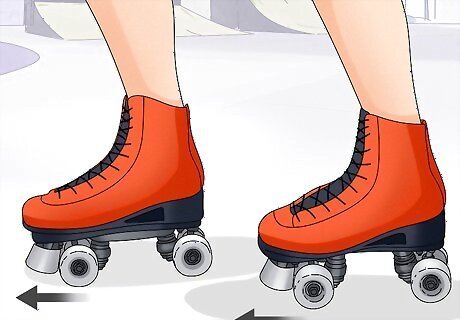
Gliding forward is one of the most basic skills they can learn. Have them keep walking forward, but tell them to lengthen their stride, and try to roll forward on one foot before picking up the other one. If they can do that, get them to push off with their back foot and roll forward on their front foot so they’re gliding instead of walking. As they glide on one foot, have them lift the other foot off the ground so it doesn’t impede their movement. Gliding is a great beginner move, and for young children, it might take them a few days (or weeks) to master. You can spend as long as you want on gliding to make sure your child feels comfortable with it before moving on.
Show them how to stop.
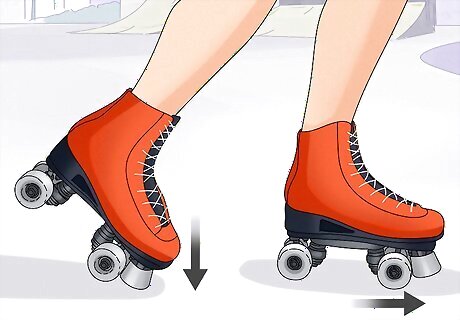
Have your child dig their toe into the ground to come to a halt. While they’re still gliding slowly, show them how to glide with their skates parallel to each other. Then, have them lean their body forward and push down with one foot, digging the toe of the skate into the ground. Remind them that it’s important to push their toe into the ground quickly and with confidence; otherwise, they might fall over. If your kid is nervous about practicing this move, have them stand in place and just practice pressing each toe into the ground. If they can feel the movement while they’re stationary, they might have an easier time doing it while they’re gliding.
Teach your child to try to make a turn.

Turning is all about shifting body weight during their glide. Have your child start gliding in a straight line, then tell them to shift their body weight to the right. As they lean over slightly, their body will naturally turn to the right in a soft turn. Get them to try that a few times on both sides until they start making tighter, faster turns. If your kid is struggling with this, have them stand stationary in one spot with their skates on. Get them to lean to the right, using their body weight to put pressure onto their right foot. Then, have them lean to the left. If they can feel which muscles they’re using while they stand still, they’ll have an easier time turning in a glide.
Work up to gaining speed.

Your child’s posture and arm stance can help them skate faster. Tell them to hunker down in their glide and lean forward. Have them pump their arms like they’re running every time they lift their foot to do another glide. Stress the importance of pushing off with their back foot and picking their other foot up really high to get some speed. Be sure to always skate on a flat surface, as gaining momentum on a hill can be dangerous for beginners.
Talk about the importance of getting up if they fall down.
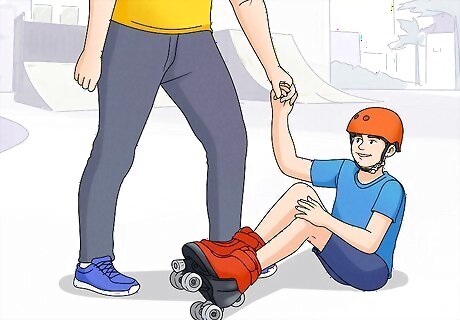
Your child might fall down as they learn, and that’s okay! Before you actually start skating, remind your child that they’re wearing safety gear, and they won’t get hurt badly if they fall over. Teach them that if they start to fall, they should put their hands out to catch themselves and try to learn forward over their toes. Then, they need to get back up right away so they can keep skating. Your reaction to your child falling is just as important as them falling safely. If you say something like, “You’re okay!” and tell them to get back up again, they’re much less likely to make a big deal out of falling. Some teachers recommend giving young children a time limit for getting back up. You might say something like, “Up, up, up! 3, 2, 1!” That way, they have an incentive to stand back up again.
Keep practicing until they’ve mastered the basics.
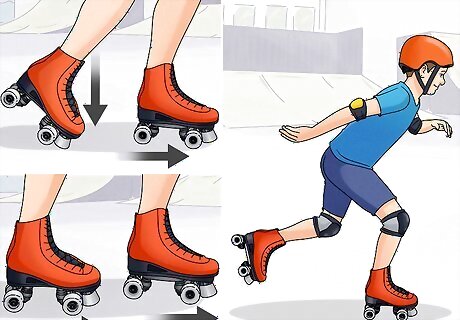
The only way for your child to get better is to practice! Little children might need more time with the basics, while older children can master it within a few weeks. However, every child is different, and yours might have different comfort levels. Be sure to check in with your child to make sure they’re feeling safe and confident, and don’t be afraid to grab their hand if they need a little extra support. Try not to push your child into doing things they don’t want to do. If they get too scared or nervous about skating, they might give it up completely. Let them work at their own pace, and support them in doing whatever they want to do.
Move on to skating backwards.
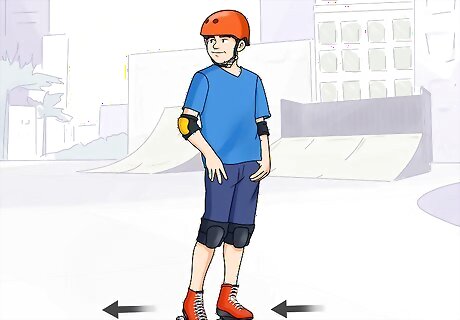
Once your kid can glide, turn, and stop, you can try a simple trick. Skating backwards is a fun trick for children to learn, and it’s not too tough. Have your child point their toes in toward each other so they look slightly pigeon-toed. Have them push themselves backwards by pushing off with their toes and leaning back into their heels. Stress the importance of keeping their feet in that V-shape to hold the backwards skating position. It’s tough to skate backwards very quickly, so this is a fun trick to learn that’s safe for beginners.
Try jumps and tricks if they’re ready.
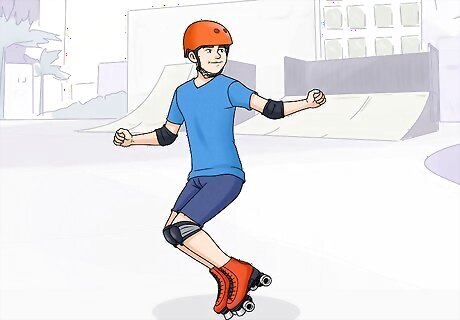
If your kid has nailed the basics, feel free to move on! They can try jumping by gliding and gaining momentum, then crouching down and lifting their feet up off the ground. They could also try doing a heel-toe by gliding and gaining momentum, then lifting the toe of one skate and lifting the heel of the other in a split stance. If you know of any fun tricks your child could learn, feel free to teach them so they can enhance their skating skills. You can also look up fun skate tricks for beginners on YouTube for inspiration.
Talk about roller rink safety.
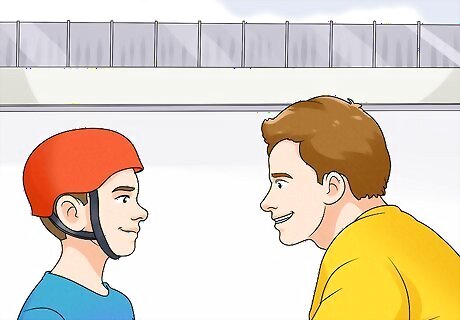
Tell them to always keep moving, and to not try any tricks at a roller rink. Before you head to a public roller rink, remind your child that they need to follow the flow of skaters, and they shouldn’t weave in and out of the line if they can help it. If they want to stop, they should skate over to an exit and get out of the roller rink so they don’t cause a crash. If they fall down, have them call for you or make their way over to the side of the rink to pull themselves up. In general, people usually skate slower toward the middle of the rink and faster toward the edge.

















Comments
0 comment